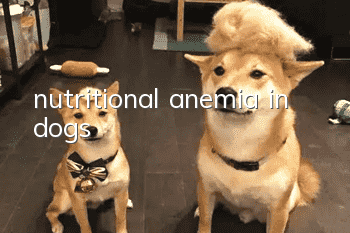nutritional anemia in dogs

Anemia refers to the lack of certain hematopoietic substances, which affects the production of red blood cells and hemoglobin. It is nutritional anemia. Dogs, like people, can suffer from anemia. What are the symptoms of anemia in dogs? How can we avoid anemia in dogs?
Cavalier King Charles Spaniel
Anemia can be divided into hemorrhagic anemia, hemolytic anemia, nutritional anemia and aplastic anemia.
(1) Hemorrhagic anemia
[Cause] Acute hemorrhagic anemia is caused by trauma or surgery causing rupture of internal organs (such as liver, spleen, vena artery and vena cava) and external blood vessels, causing massive bleeding, resulting in a sudden decrease in the body's hemolytic capacity.
Chronic hemorrhagic anemia is mainly caused by chronic inflammation of the stomach and intestines, hemorrhagic inflammation of the lungs, kidneys, bladder, and uterus, resulting in long-term repeated bleeding. In addition, canine hookworm infection can also cause chronic hemorrhagic anemia.
[Symptoms] Common symptoms include visible mucous membranes, pale skin, rapid heartbeat, and general muscle weakness. Symptoms are proportional to the amount of bleeding. Excessive bleeding may cause collapse, restlessness, decreased blood pressure, coldness in the limbs, ears and nose, unsteady gait, and muscle tremors. In the later stage, drowsiness, coma, and shock may be seen.
For dogs with small amounts of bleeding or chronic bleeding, the initial symptoms are not obvious. However, the sick dog can gradually lose weight, and the visible mucosa gradually develops from light red to white. It is listless, has general weakness, lethargy, is inactive, has a fast and weak pulse, and has shallow breathing. Slight edema of the lower jaw and limbs is often seen. Severe cases can lead to shock, heart failure and death.
[Diagnosis] According to clinical symptoms, red blood cell count and hematocrit examination can confirm the diagnosis.
[Treatment] Stop bleeding and restore hemolysis.
① For traumatic bleeding, ligation, compression, and tourniquet can be used to stop bleeding. For bleeding at the end of the limbs, owners can use a tourniquet to stop the bleeding and immediately send them to a veterinary hospital for treatment.
② Injection of hemostatic drugs: hemostasis 25 mg/kg body weight; vitamin K 30.4 mg/kg body weight; vitamin K 11 mg/kg body weight; coagulopathy 1.5 mg/kg body weight.
③ To supplement hemolysis, dextran, glucose, compound saline, and amino acid preparations can be infused intravenously. Veterinary hospitals with conditions should provide blood transfusion therapy.
(2) Hemolytic anemia
Anemia caused by massive destruction of red blood cells due to various reasons is called hemolytic anemia.
[Cause]
① Caused by infectious factors. Such as leptospirosis, herpes pathogens, trypanosomiasis, hemolytic streptococcus infection, etc.
②Toxic diseases. Heavy metal poisoning such as: lead, copper, arsenic, mercury, etc.; chemical drug poisoning: benzene, phenol, sulfonamide, etc. Hemolytic anemia can also be caused by police dogs inhaling TNT explosives while performing tasks.
③Antigen-antibody reaction. Hemolytic anemia in newborn dogs. Because the blood type of the newborn is different from that of the mother dog, an antigen-antibody reaction occurs after ingesting breast milk, resulting in hemolytic anemia in the puppies. Transfusion of heterotypic blood types can also cause hemolysis.
Other factors, such as febrile disease, lymphosarcoma, myeloid leukemia, plasma hemoglobinemia, red blood cell pyruvate kinase deficiency and other factors can cause hemolytic anemia.
[Symptoms] The main symptoms are visible yellowing of the mucous membranes, yellowing of the corners of the skin and mouth, depression, weakness in movement, and weight loss. In the later stage, the visible mucous membranes may become white and yellow, lethargic, hemoglobinuria, and body weight loss.
[Treatment] Expand the hemolysis volume, remove the cause, and treat symptoms. Rehydration and blood transfusion therapy. For toxic diseases, antidotes are given; for parasitic infections, insecticides are given for treatment. Also combined with hormonal therapy, such as cortisone, prednisone, and dexamethasone.
(3) Nutritional anemia
Nutritional anemia refers to anemia caused by the lack of certain hematopoietic substances that affects the production of red blood cells and hemoglobin.
[Cause] Mainly caused by protein, iron, copper, cobalt, and vitamin deficiency.
① Protein deficiency: caused by insufficient protein intake by animals or chronic digestive dysfunction.
② Trace element deficiency: iron, copper, and cobalt deficiency. Clinically, iron deficiency anemia is common. Iron is an essential component for hemoglobin synthesis; copper deficiency can also lead to reduced hemoglobin synthesis.
③ Vitamin deficiency: Deficiency of vitamin B1, vitamin B12, vitamin B6, folic acid, niacin, etc. can lead to disorders in the production of red blood cells and hemoglobin synthesis, resulting in nutritional anemia.
Most of the above factors are caused by the dog's single food, chronic digestive tract diseases and intestinal parasitic diseases, which cause intestinal absorption dysfunction, leading to nutritional anemia over time. :
[Symptoms] Nutritional anemia develops slowly and mainly manifests as progressive weight loss and malnutrition. Physical weakness, abdominal curling, rough coat, pale mucous membranes, high degree of weakness in movement in the later stage, shaking, difficulty in standing up after falling to the ground, until lying on the ground and complete body failure.
[Treatment] Strengthen feeding, supplement hematopoietic substances, and provide protein-rich and vitamin-rich foods.
Ferrous sulfate 50 mg/kg body weight, taken orally 2-3 times/day. Cobalt chloride 0.3% solution, 3-5 ml/day orally.
Vitamin B15-10 mg/kg body weight, vitamin B125-10 ml/kg body weight, mixed intramuscular injection, 1 time/day. Folic acid 1-3 mg/kg body weight, taken orally, once a day.
In addition, glucose and various amino acid preparations can be supplemented to help restore body function.
(4)Aplastic anemia
Aplastic anemia refers to anemia caused by impairment of bone marrow hematopoietic function.
[Cause])
Poisoning. Certain heavy metals, such as gold, arsenic, bismuth, etc.; certain organic compounds, such as benzene, phenol, trichlorethylene, etc.; certain excessive therapeutic drugs, such as chloramphenicol, sulfa drugs. Both can cause aplastic anemia.
(2) Radiation damage. Exposure to large amounts of X-rays and certain radioactive elements. It can be damaged by bone marrow cells, red blood cells, osteoid cells and megakaryocytes, causing these cells to suffer irreversible damage, leading to loss of hematopoietic function.
(3) Certain diseases. For example: chronic kidney disease, leukemia, hematopoietic organ tumors, etc., can all lead to aplastic anemia. * i2 b; l9 X# K*
[Symptoms]The clinical symptoms of aplastic anemia develop relatively slowly. In addition to the above three anemia symptoms, they are mainly manifested in changes in the blood image, low levels of red blood cells and white and red proteins, and reticular patterns in the blood. Red blood cells disappear.
[Treatment] Improve hematopoietic function and replenish blood volume.
(1) Blood transfusion therapy. Blood transfusion is performed after a blood matching test, and the blood transfusion rate should be slow, usually 10-15 ml/kg of body weight per hour. The amount of blood transfusion can be given according to the specific volume of the sick dog.
(2) Anabolic hormone therapy. For example: Testosterone (can stimulate red blood cell production) 1-2 mg/kg body weight, intramuscular injection, 1-3 times a week; Stanozolol 0.4-0.6 mg/kg body weight, taken orally once every 2-3 days.
Secondly, let’s talk about the importance of deworming.
The most common internal parasite in dogs is roundworms. Most of these parasites are transmitted vertically from their mothers. In addition to stunted development, puppies infected with roundworms may also have symptoms such as diarrhea, vomiting, and flatulence. Therefore, it is best to start expelling puppies about one month after they are born.insect. If it is hookworm parasitism, in addition to a big belly, there will also be vomiting and mild bloody stools. Usually the initial symptoms of infection are not obvious, but when the infection is severe or other complications occur, the symptoms become obvious, and the bleeding is more serious. If no treatment is carried out, acute anemia or other complications may occur, leading to death. . In addition, there are many kinds of internal parasites in dogs, such as canine tapeworm, canine whipworm, canine trichinella, canine paragonimiasis, canine liver fluke, etc. Dogs usually eat more when infected with parasites, but they never gain weight no matter how much they eat. Some owners think parasites are a minor disease and often do not pay attention to them. Don’t you know that it is very harmful, because parasites are infectious diseases that can be transmitted to humans and animals, and children with weak immunity can easily cause infection after touching a sick dog, or by kissing the dog head-to-head. Especially like hookworms, if the owner goes barefoot, the hookworms will burrow into the skin. People with strong immunity are less likely to be infected, but people with weak immunity may not be able to survive. Moreover, many parasites can endanger a dog’s life
The last thing to emphasize is that when choosing puppies, don’t blindly pursue small ones. There are quite a few unscrupulous sellers who pursue the size of their newborn dogs. Use the method of starvation to force the puppies to be small. The result is that puppies are hungry for a long time, their gastrointestinal function atrophies, and they cause nutritional anemia.
- How to avoid getting your dog pregnant
- What to do if your Bichon Frize keeps having diarrhea? How to treat your Bichon Frize to have diarrhea!
- Causes, Symptoms and Treatment of Difficult Labor in Dogs
- What can’t Tibetan Mastiffs eat?
- How to train a dog to fetch a ball. Commands and rewards are both crucial.
- What should I do if one of my dog’s nails turns black?
- Oral diseases commonly suffered by dogs
- How to express anal glands in dogs
- How many months does a male Labrador mature?
- Only by understanding your dog’s habits can you raise a good dog!



